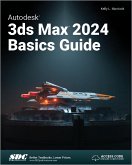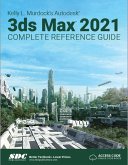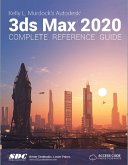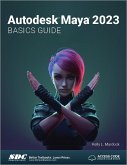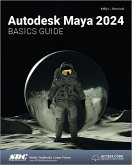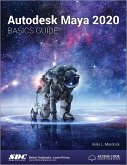Kelly L. Murdock
Autodesk 3ds Max 2025 Basics Guide
Kelly L. Murdock
Autodesk 3ds Max 2025 Basics Guide
- Broschiertes Buch
- Merkliste
- Auf die Merkliste
- Bewerten Bewerten
- Teilen
- Produkt teilen
- Produkterinnerung
- Produkterinnerung
Discover the world of 3D Modeling and animation with Autodesk 3ds Max 2025 Basics Guide, a comprehensive and user-friendly guide designed for beginners and professionals alike.
Andere Kunden interessierten sich auch für
![Autodesk 3ds Max 2024 Basics Guide Autodesk 3ds Max 2024 Basics Guide]() Kelly L. MurdockAutodesk 3ds Max 2024 Basics Guide93,99 €
Kelly L. MurdockAutodesk 3ds Max 2024 Basics Guide93,99 €![Kelly L. Murdock's Autodesk 3ds Max 2021 Complete Reference Guide Kelly L. Murdock's Autodesk 3ds Max 2021 Complete Reference Guide]() Kelly L. MurdockKelly L. Murdock's Autodesk 3ds Max 2021 Complete Reference Guide83,99 €
Kelly L. MurdockKelly L. Murdock's Autodesk 3ds Max 2021 Complete Reference Guide83,99 €![Kelly L. Murdock's Autodesk 3ds Max 2020 Complete Reference Guide Kelly L. Murdock's Autodesk 3ds Max 2020 Complete Reference Guide]() Kelly L. MurdockKelly L. Murdock's Autodesk 3ds Max 2020 Complete Reference Guide83,99 €
Kelly L. MurdockKelly L. Murdock's Autodesk 3ds Max 2020 Complete Reference Guide83,99 €![Autodesk Maya 2023 Basics Guide Autodesk Maya 2023 Basics Guide]() Kelly L. MurdockAutodesk Maya 2023 Basics Guide96,99 €
Kelly L. MurdockAutodesk Maya 2023 Basics Guide96,99 €![Autodesk Maya 2024 Basics Guide Autodesk Maya 2024 Basics Guide]() Kelly L. MurdockAutodesk Maya 2024 Basics Guide94,99 €
Kelly L. MurdockAutodesk Maya 2024 Basics Guide94,99 €![Autodesk Maya 2020 Basics Guide Autodesk Maya 2020 Basics Guide]() Kelly L. Murdock (USA SDC Publications)Autodesk Maya 2020 Basics Guide91,99 €
Kelly L. Murdock (USA SDC Publications)Autodesk Maya 2020 Basics Guide91,99 €![Autodesk Revit 2023 Architecture Certification Exam Study Guide Autodesk Revit 2023 Architecture Certification Exam Study Guide]() Elise MossAutodesk Revit 2023 Architecture Certification Exam Study Guide85,99 €
Elise MossAutodesk Revit 2023 Architecture Certification Exam Study Guide85,99 €-
-
-
Discover the world of 3D Modeling and animation with Autodesk 3ds Max 2025 Basics Guide, a comprehensive and user-friendly guide designed for beginners and professionals alike.
Hinweis: Dieser Artikel kann nur an eine deutsche Lieferadresse ausgeliefert werden.
Hinweis: Dieser Artikel kann nur an eine deutsche Lieferadresse ausgeliefert werden.
Produktdetails
- Produktdetails
- Verlag: SDC Publications
- Seitenzahl: 900
- Erscheinungstermin: 15. August 2024
- Englisch
- Abmessung: 251mm x 203mm x 46mm
- Gewicht: 1842g
- ISBN-13: 9781630576783
- ISBN-10: 1630576786
- Artikelnr.: 71263739
- Herstellerkennzeichnung
- Libri GmbH
- Europaallee 1
- 36244 Bad Hersfeld
- gpsr@libri.de
- Verlag: SDC Publications
- Seitenzahl: 900
- Erscheinungstermin: 15. August 2024
- Englisch
- Abmessung: 251mm x 203mm x 46mm
- Gewicht: 1842g
- ISBN-13: 9781630576783
- ISBN-10: 1630576786
- Artikelnr.: 71263739
- Herstellerkennzeichnung
- Libri GmbH
- Europaallee 1
- 36244 Bad Hersfeld
- gpsr@libri.de
Preface Acknowledgments Front Matter Part I: Getting Started with Autodesk
3ds Max 2025 1. Exploring the 3ds Max Interface 2. Controlling and
Configuring the Viewports 3. Working with Files, Importing, and Exporting
Part II: Manipulating Objects 4. Creating and Editing Primitives and
Selecting Objects 5. Transforming Objects, Pivoting, Aligning, and Snapping
6. Cloning Objects and Creating Object Arrays 7. Grouping, Linking and
Parenting Objects 8. Organizing Scenes with Layers, Containers, and XRefs
Part III: Modeling 3D Assets 9. Accessing Subobjects and Modifiers and
Using the Modifier Stack 10. Drawing and Editing 2D Splines and Shapes 11.
Modeling with Polygons 12. Using the Graphite Modeling Tools and Painting
with Objects 13. Working with Compound Objects 14. Using Mesh Modifiers and
Deforming Surfaces Part IV: Applying Materials and Textures 15. Creating
and Applying Materials with the Slate Material Editor 16. Adding Material
Details with Maps 17. Creating Compound Materials and Using Material
Modifiers Part V: Setting the Scene: Cameras, Lights, and Rendering 18.
Configuring Cameras and Environments 19. Using Lights and Basic Lighting
Techniques 20. Rendering a Scene and Working with Arnold Part VI: Animating
Objects and Scenes 21. Understanding Animation and Keyframes 22. Using
Animation Layers and Animation Modifiers 23. Animating with Constraints and
Simple Controllers 24. Editing Animation Curves in the Track View Part VII:
Working with Characters and Special Effects 25. Understanding Rigging,
Kinematics, and Working with Bones and Skin 26. Animating Characters with
CAT 27. Using Particles and Space Warps 28. Using Atmospheric, Render, and
Lighting Effects Part VIII: Using Dynamic Animation Systems 29. Simulating
Physics-Based Motion with MassFX 30. Working with Hair, Cloth, and Fluids
Index
3ds Max 2025 1. Exploring the 3ds Max Interface 2. Controlling and
Configuring the Viewports 3. Working with Files, Importing, and Exporting
Part II: Manipulating Objects 4. Creating and Editing Primitives and
Selecting Objects 5. Transforming Objects, Pivoting, Aligning, and Snapping
6. Cloning Objects and Creating Object Arrays 7. Grouping, Linking and
Parenting Objects 8. Organizing Scenes with Layers, Containers, and XRefs
Part III: Modeling 3D Assets 9. Accessing Subobjects and Modifiers and
Using the Modifier Stack 10. Drawing and Editing 2D Splines and Shapes 11.
Modeling with Polygons 12. Using the Graphite Modeling Tools and Painting
with Objects 13. Working with Compound Objects 14. Using Mesh Modifiers and
Deforming Surfaces Part IV: Applying Materials and Textures 15. Creating
and Applying Materials with the Slate Material Editor 16. Adding Material
Details with Maps 17. Creating Compound Materials and Using Material
Modifiers Part V: Setting the Scene: Cameras, Lights, and Rendering 18.
Configuring Cameras and Environments 19. Using Lights and Basic Lighting
Techniques 20. Rendering a Scene and Working with Arnold Part VI: Animating
Objects and Scenes 21. Understanding Animation and Keyframes 22. Using
Animation Layers and Animation Modifiers 23. Animating with Constraints and
Simple Controllers 24. Editing Animation Curves in the Track View Part VII:
Working with Characters and Special Effects 25. Understanding Rigging,
Kinematics, and Working with Bones and Skin 26. Animating Characters with
CAT 27. Using Particles and Space Warps 28. Using Atmospheric, Render, and
Lighting Effects Part VIII: Using Dynamic Animation Systems 29. Simulating
Physics-Based Motion with MassFX 30. Working with Hair, Cloth, and Fluids
Index
Preface Acknowledgments Front Matter Part I: Getting Started with Autodesk
3ds Max 2025 1. Exploring the 3ds Max Interface 2. Controlling and
Configuring the Viewports 3. Working with Files, Importing, and Exporting
Part II: Manipulating Objects 4. Creating and Editing Primitives and
Selecting Objects 5. Transforming Objects, Pivoting, Aligning, and Snapping
6. Cloning Objects and Creating Object Arrays 7. Grouping, Linking and
Parenting Objects 8. Organizing Scenes with Layers, Containers, and XRefs
Part III: Modeling 3D Assets 9. Accessing Subobjects and Modifiers and
Using the Modifier Stack 10. Drawing and Editing 2D Splines and Shapes 11.
Modeling with Polygons 12. Using the Graphite Modeling Tools and Painting
with Objects 13. Working with Compound Objects 14. Using Mesh Modifiers and
Deforming Surfaces Part IV: Applying Materials and Textures 15. Creating
and Applying Materials with the Slate Material Editor 16. Adding Material
Details with Maps 17. Creating Compound Materials and Using Material
Modifiers Part V: Setting the Scene: Cameras, Lights, and Rendering 18.
Configuring Cameras and Environments 19. Using Lights and Basic Lighting
Techniques 20. Rendering a Scene and Working with Arnold Part VI: Animating
Objects and Scenes 21. Understanding Animation and Keyframes 22. Using
Animation Layers and Animation Modifiers 23. Animating with Constraints and
Simple Controllers 24. Editing Animation Curves in the Track View Part VII:
Working with Characters and Special Effects 25. Understanding Rigging,
Kinematics, and Working with Bones and Skin 26. Animating Characters with
CAT 27. Using Particles and Space Warps 28. Using Atmospheric, Render, and
Lighting Effects Part VIII: Using Dynamic Animation Systems 29. Simulating
Physics-Based Motion with MassFX 30. Working with Hair, Cloth, and Fluids
Index
3ds Max 2025 1. Exploring the 3ds Max Interface 2. Controlling and
Configuring the Viewports 3. Working with Files, Importing, and Exporting
Part II: Manipulating Objects 4. Creating and Editing Primitives and
Selecting Objects 5. Transforming Objects, Pivoting, Aligning, and Snapping
6. Cloning Objects and Creating Object Arrays 7. Grouping, Linking and
Parenting Objects 8. Organizing Scenes with Layers, Containers, and XRefs
Part III: Modeling 3D Assets 9. Accessing Subobjects and Modifiers and
Using the Modifier Stack 10. Drawing and Editing 2D Splines and Shapes 11.
Modeling with Polygons 12. Using the Graphite Modeling Tools and Painting
with Objects 13. Working with Compound Objects 14. Using Mesh Modifiers and
Deforming Surfaces Part IV: Applying Materials and Textures 15. Creating
and Applying Materials with the Slate Material Editor 16. Adding Material
Details with Maps 17. Creating Compound Materials and Using Material
Modifiers Part V: Setting the Scene: Cameras, Lights, and Rendering 18.
Configuring Cameras and Environments 19. Using Lights and Basic Lighting
Techniques 20. Rendering a Scene and Working with Arnold Part VI: Animating
Objects and Scenes 21. Understanding Animation and Keyframes 22. Using
Animation Layers and Animation Modifiers 23. Animating with Constraints and
Simple Controllers 24. Editing Animation Curves in the Track View Part VII:
Working with Characters and Special Effects 25. Understanding Rigging,
Kinematics, and Working with Bones and Skin 26. Animating Characters with
CAT 27. Using Particles and Space Warps 28. Using Atmospheric, Render, and
Lighting Effects Part VIII: Using Dynamic Animation Systems 29. Simulating
Physics-Based Motion with MassFX 30. Working with Hair, Cloth, and Fluids
Index


